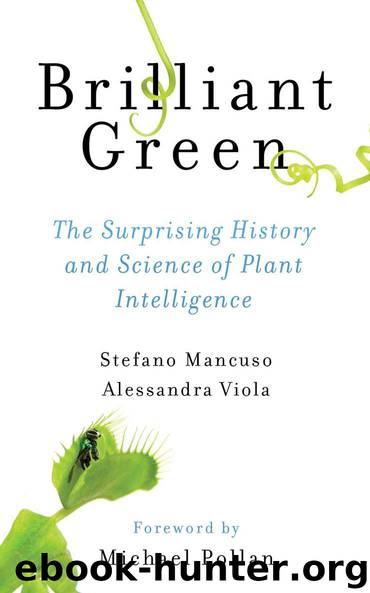Brilliant Green: The Surprising History and Science of Plant Intelligence by Stefano Mancuso & Alessandra Viola

Author:Stefano Mancuso & Alessandra Viola [Mancuso, Stefano]
Language: eng
Format: epub
Publisher: Island Press
Published: 2015-03-11T23:00:00+00:00
Figure 4-1. The structure of the stomata (top). By means of these small openings on their surfaces, the leaves take in the carbon dioxide they need for photosynthesis and give off water vapor. Under normal conditions, the stomata’s cycle of opening and closing (bottom) is controlled by the presence and intensity of light.
The Stomata
Before we come to a concrete example, let’s look at the functioning of the stomata (from the Greek stoma, “mouth,” “opening”), special structures on the surfaces of the leaves (usually on their undersides). These small openings put the inside of the plant in communication with the outside, much like the pores of our skin. Regulating each stoma are two “guard cells,” which control its opening and closing based on the current water and light conditions of the plant organism.
The stomata’s task is much more complex than it might seem. In fact, balancing the plant’s different requirements is far from simple: on the one hand, because carbon dioxide (CO2, necessary to carry out photosynthesis) enters through the stomata, the plant would seem to have every interest in keeping them open—at least during the daylight hours; but on the other hand, when the stomata are open the plant loses a great deal of water through transpiration.
Every plant has to respond to a real dilemma: keep the stomata open, and through photosynthesis produce the sugars necessary for survival, even if that means losing a great deal of water; or close them, conserving the water it needs but forgoing photosynthesis. It’s such a difficult problem that in order to understand how the plant can make the right decision, concepts such as “collective dynamic” or “emergent distributed computing” have been invoked, though they seem a bit out of place applied to plants.
However the plant does it, what’s certain is that it reaches a compromise between the exigencies of producing sugar and not losing water, both of which are essential to its survival. Let’s look at an example: the summer sun, with its powerful rays, is precious for photosynthesis, as it is for our solar panels. Unlike the latter, however, which produce more energy the more sunlight they’re exposed to, a plant must take into account not only light but its reserves of water. This is why during the midday hours—the hottest—it closes its stomata, depriving them of a great opportunity for photosynthesis. By doing so the plant protects itself from the risk of getting too dehydrated.
Imagine a tree (for example an oak or a very tall sequoia), whose roots suddenly notice that there’s not enough water available in the soil. Communicating that fact to the leaves is now imperative: if the stomata remained open, continuing to transpire water, the plant could die in a very short time. A very grave danger! So this message is essential for the tree’s survival and must travel fast.
To speed it along, as a first option, the plant utilizes an electrical signal, which in a short time reaches the leaves, prompting the stomata to close. At the
Download
This site does not store any files on its server. We only index and link to content provided by other sites. Please contact the content providers to delete copyright contents if any and email us, we'll remove relevant links or contents immediately.
| Anatomy | Animals |
| Bacteriology | Biochemistry |
| Bioelectricity | Bioinformatics |
| Biology | Biophysics |
| Biotechnology | Botany |
| Ecology | Genetics |
| Paleontology | Plants |
| Taxonomic Classification | Zoology |
Sapiens: A Brief History of Humankind by Yuval Noah Harari(14257)
The Tidewater Tales by John Barth(12609)
Mastermind: How to Think Like Sherlock Holmes by Maria Konnikova(7233)
Do No Harm Stories of Life, Death and Brain Surgery by Henry Marsh(6891)
The Thirst by Nesbo Jo(6832)
Why We Sleep: Unlocking the Power of Sleep and Dreams by Matthew Walker(6620)
Life 3.0: Being Human in the Age of Artificial Intelligence by Tegmark Max(5478)
Sapiens by Yuval Noah Harari(5295)
The Longevity Diet by Valter Longo(5021)
The Body: A Guide for Occupants by Bill Bryson(4978)
The Rules Do Not Apply by Ariel Levy(4866)
The Immortal Life of Henrietta Lacks by Rebecca Skloot(4528)
Animal Frequency by Melissa Alvarez(4399)
Why We Sleep by Matthew Walker(4362)
The Hacking of the American Mind by Robert H. Lustig(4319)
Yoga Anatomy by Kaminoff Leslie(4309)
All Creatures Great and Small by James Herriot(4233)
Double Down (Diary of a Wimpy Kid Book 11) by Jeff Kinney(4209)
Embedded Programming with Modern C++ Cookbook by Igor Viarheichyk(4108)
